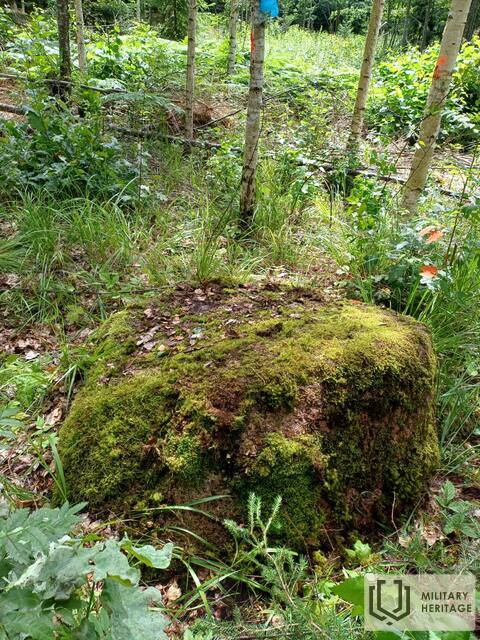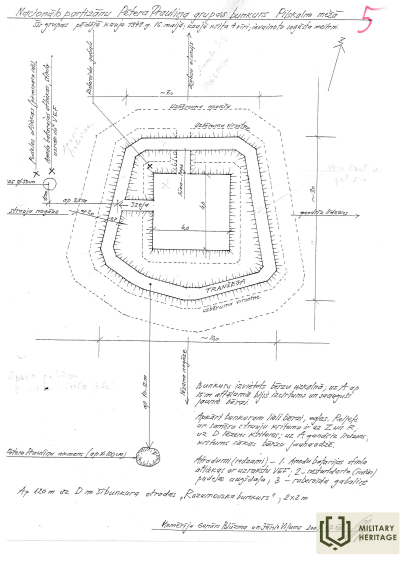P. Praulinio nacionalinės partizanų grupės bunkerio vieta
Bunkeris


 179
179




P. Praulinio bunkerio vieta yra Vidsalos kvartalo 99 4-oje dalyje, Kalnos valsčiuje. Akmuo, ant kurio sėdėjo P. Praulinis, yra išsaugotas.
P. Praulinio (1911–1949) partizanų grupė Kalnos miške Biržų valsčiuje buvo sunaikinta 1949 m. gegužės 16 d. Latvijos SSR Valstybės saugumo ministerijos operacijos, kurioje dalyvavo ir kariniai daliniai, metu. Miško broliai buvo įsirengę gerai užmaskuotą bunkerį su perimetro gynyba, kuris buvo įsikūręs nenustatytame aukštyje pelkėtoje vietovėje. Partizanai mažiausiai 40 minučių įnirtingai priešinosi Čekos kariuomenei, tačiau krito visa grupė: Pēteris Prauliņš, Artūras Bružukas, Jānis Kalvāns, Edvīns Slikšāns ir Francis Skromanis. Sušaudyti miško broliai buvo numesti netoli parapijos namų, tačiau jų palaikai vėliau buvo palaidoti netoliese esančiuose žvyrduobėse. Sunkiai sužeista buvo Irma Bružuka, kuri buvo paimta į nelaisvę ir mirė gegužės 17 d. Jekabpilio ligoninėje. Ji buvo palaidota už kapinių ribų, tačiau, kai kapinės buvo išplėstos po Latvijos nepriklausomybės atgavimo, ant jos kapo buvo pastatytas paminklas.
Biržų parapijos nacionalinis partizanų Peterio Praulinio būrelis priklausė Mārtiņa Pokļevinskio (1902–1951) vadovaujamai grupei. Ši grupė vykdė keletą partizaninių akcijų, kurių metu buvo baudžiami sovietų kolaborantai, rekvizuojamas okupacinės valdžios ekonominių įstaigų maistas ir turtas. P. Praulinio būrio partizanai nesilaikė pakankamos konspiracijos, daugelis asmenų lankydavosi jų gyvenvietėje, o tai sudarė sąlygas išdavystei. Karinės patirties stoka buvo vienas iš partizaninio ginkluoto judėjimo trūkumų.
Atminimo akmuo P. Praulinio grupės partizanams Kalnos parapijoje buvo pašventintas 1998 m. lapkritį.
Panaudoti šaltiniai ir literatūra:
H. Bruņinieks. Apgaudinėja mirtį. Ryga: Latvijos žiniasklaida, 2022, 227–229, 242 p.
Nežinomas karas. Latvijos nacionalinių partizanų kova su sovietų okupantais 1944–1956 m. 1-asis leidimas. Ryga: Domas sūks, 2010, p. 326–327.
Susijusi laiko juosta
Susijusi istorija
Selio miško brolių gyvenvietė Sūpės pelkėje
Sūpės pelkė siejama su nacionalinių partizanų gyvenviečių ir mūšių vietomis, kurios susiformavo sąveikaujant žmonėms ir vietovėms. Ji aprašyta tremtinio latvių rašytojo Alberto Eglīčio baladėje apie įvykius jo gimtojoje Sūpės pelkėje „Samanose ir purve“ – duoklėje Sūpės pelkės partizanams:
... „1945 m., kai pelkėje švytėjo ruduo –
Pokļevinskio gimtadienio proga Lieljānis vakarienės metu dalijasi:
Gluosniuose fermentuotas alus,
Romulanai garbina sviestą,
Džiovinu mamos kmynų duoną,
Džiovintas kumpis kovo mėnesio gabalėliuose,
Ir Stučkos svogūnai,
Ildzeniecės sūris.
Kambariai dervingose sienose
Ir žaibas trenkė širdyse,
Ir vienuolikoje sielų merdi –
"Žemėje supuvusios šaknys..."
Ši praeities interpretacija su įvykiais po Antrojo pasaulinio karo apėmė žmonių liudijimus, dvasios išraiškas ir vertybių sistemas. Ji primena visuomenės paramą nacionaliniams partizanams, kurių okupacinė valdžia negalėjo taip lengvai nugalėti.






